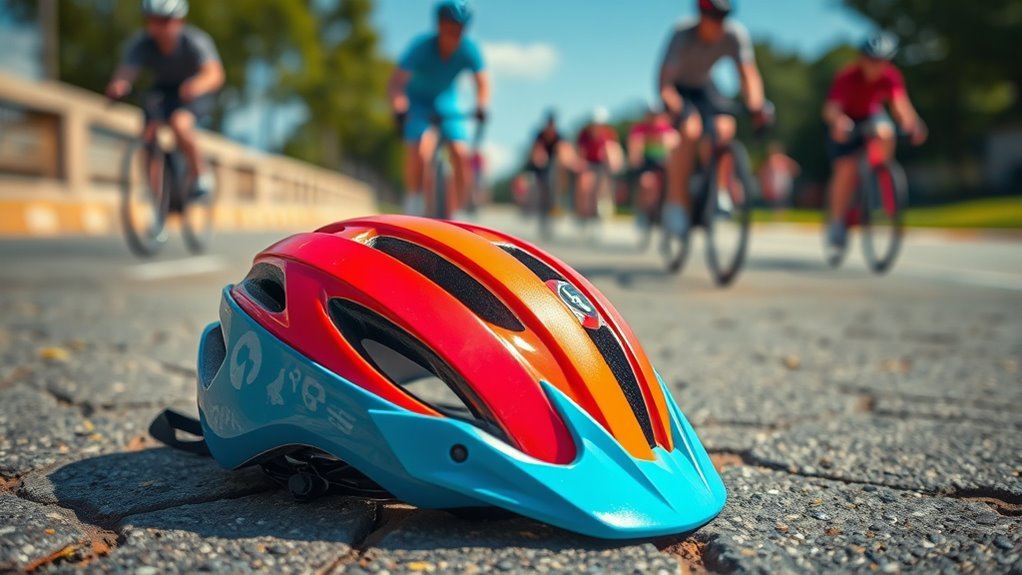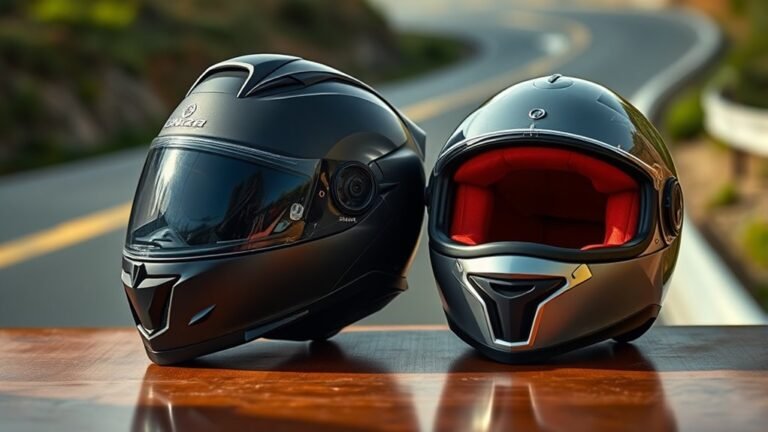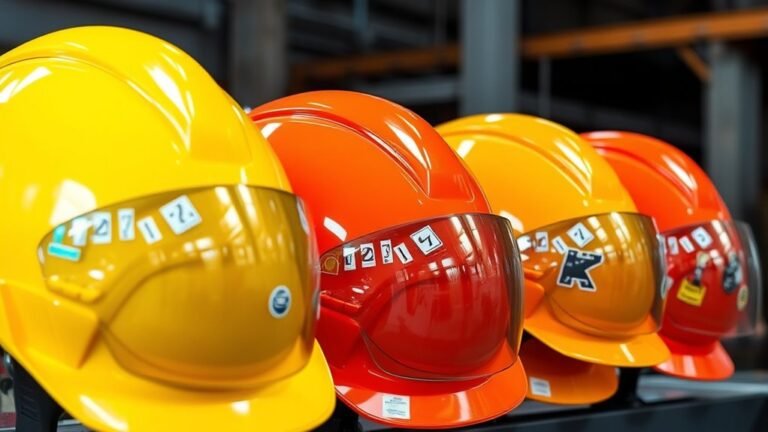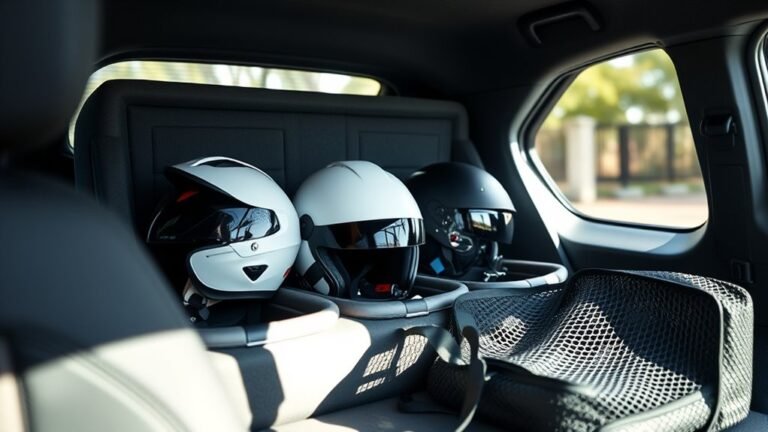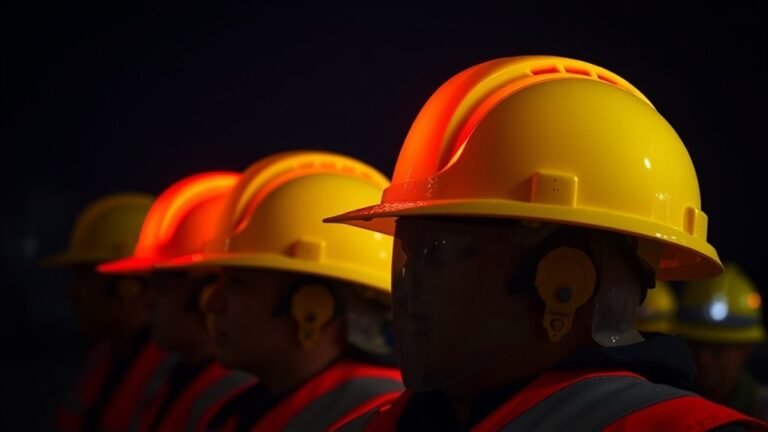Helmet Safety Myths Debunked: What You Need to Know
Helmet safety myths can put you at risk. Helmets aren’t just for kids; they’re essential for all riders. They greatly reduce the chances of serious injuries, like concussions and skull fractures, by up to 85%. Not all helmets offer equal protection, so look for quality certifications. Also, replacing helmets after a crash is important for safety. Wearing a helmet doesn’t promote risky behavior; it encourages safer riding habits. Discover more about these myths and their truths.
Myth 1: Helmets Are Only for Children

Why do so many people believe that helmets are only for children? This common helmet misconception undermines safety awareness for adults. Helmets aren’t just a childhood accessory; they’re vital for anyone who rides bikes, scooters, or motorcycles. Statistics show that adults are just as likely to suffer head injuries in accidents. By wearing a helmet, you’re not only protecting yourself but also setting a positive example for younger riders. Ignoring this safety measure can lead to severe consequences. Embracing helmet use as an adult promotes a culture of safety and responsibility. So next time you hit the road, remember that helmets are for everyone, regardless of age. Prioritizing your safety is not just smart; it’s essential.
Myth 2: A Helmet Can’t Protect Against Serious Injuries
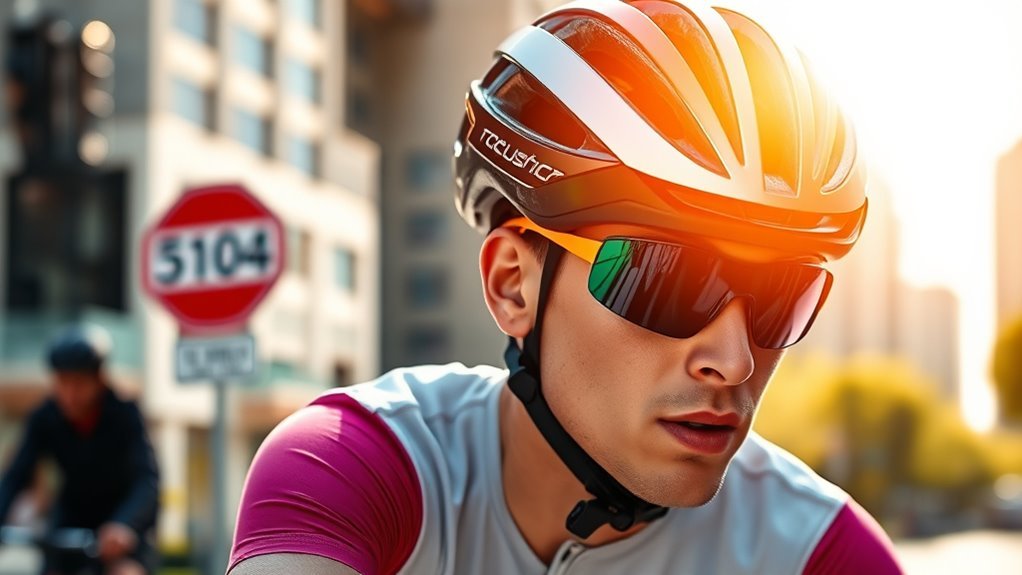
Many people mistakenly believe that a helmet can’t protect against serious injuries, which can lead to dangerous choices. The truth is, helmets are designed with specific materials and structures that absorb impact, markedly enhancing helmet effectiveness. They’re proven to reduce the risk of head injuries during accidents, including concussions and skull fractures. While no helmet can guarantee complete protection, studies show that wearing one can lower injury rates by up to 85%. Choosing the right helmet for your activity is vital for ideal injury prevention. So, whether you’re biking, skateboarding, or riding a motorcycle, don’t underestimate the protective power of a helmet. It’s a simple step that can provide essential safety and peace of mind.
Myth 3: All Helmets Are Created Equal
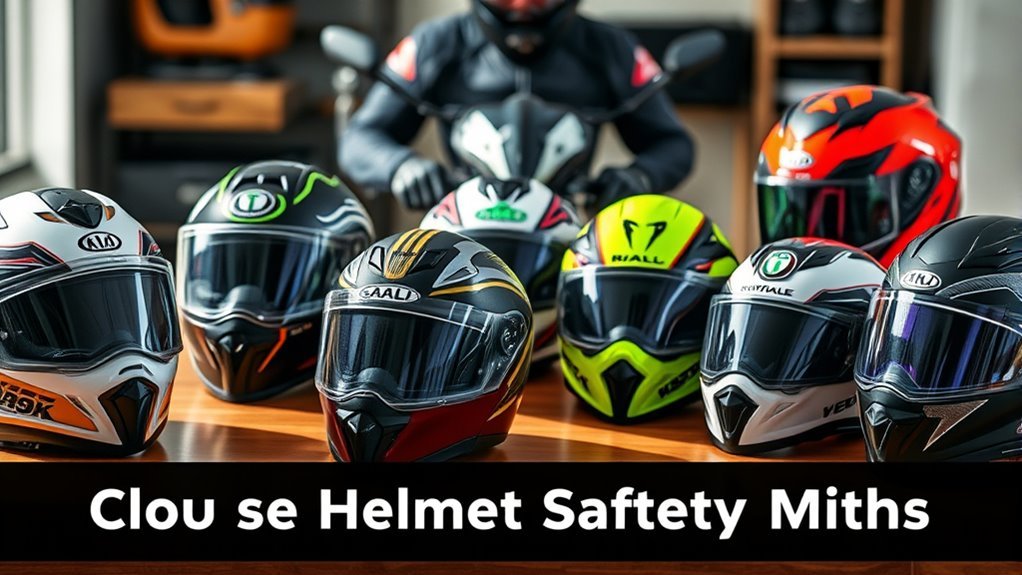
Although it might seem that all helmets offer the same level of protection, this couldn’t be further from the truth. Helmets vary greatly regarding design, materials, and effectiveness. Not all helmets meet the same safety standards, and understanding helmet ratings is essential. When shopping for a helmet, look for certifications from organizations like the Consumer Product Safety Commission or Snell Memorial Foundation. These ratings indicate that a helmet has passed rigorous testing and offers a higher level of protection. Remember, investing in a quality helmet tailored to your activity can greatly enhance your safety. Don’t settle for a helmet just because it looks good; prioritize protection and verify it meets established safety standards. Your freedom depends on it.
Myth 4: You Don’t Need to Replace a Helmet After a Crash
Even if a helmet appears undamaged after a crash, it’s important to understand that its protective capabilities may be compromised. The materials used in helmets are designed to absorb crash impact, but even minor collisions can affect helmet integrity. This means that a helmet might not provide the same level of protection in future accidents. Manufacturers often recommend replacing a helmet after any significant impact, regardless of visible damage. By doing so, you guarantee you’re fully protected on your rides. Remember, safety should never be an afterthought. Prioritizing a reliable helmet not only safeguards you but also enhances your freedom to enjoy the open road with confidence. Don’t take unnecessary risks—always replace your helmet after a crash.
Myth 5: A Tight Helmet Is Safer
Many people believe that a tight helmet offers better protection, but that’s not the whole story. A proper fit guarantees comfort and safety, allowing for better airflow and reducing the risk of distraction while riding. If a helmet is too tight, it can actually compromise your ability to wear it properly and may not provide the protection you need.
Proper Fit Is Key
When it comes to helmet safety, the belief that a tighter fit offers better protection is a common misconception. A properly fitting helmet should feel snug but not overly tight. An effective fit assessment is essential; it guarantees the helmet sits level on your head, covering your forehead without obstructing your vision. Remember, helmets come in various sizing options, so don’t hesitate to try different sizes and styles. A well-fitted helmet can absorb impact effectively, reducing injury risk. If your helmet feels uncomfortably tight, it may not provide the protection you need. Prioritize a fit that allows for comfort and safety, giving you the freedom to enjoy your activities without unnecessary worry.
Comfort vs. Safety Balance
Finding the right balance between comfort and safety in helmet use is essential for effective protection. Many believe that a tight helmet offers better safety, but that’s a myth. In reality, a helmet should fit snugly without causing discomfort. When you prioritize comfort features, you’re more likely to wear your helmet consistently. Safety standards dictate that helmets must absorb impact without compromising fit. A properly fitted helmet allows for ventilation and movement, ensuring you stay comfortable during your ride. Remember, an uncomfortable helmet can lead to distractions, increasing your risk of accidents. Choose a helmet that meets safety standards while providing the comfort you need, so you can enjoy your freedom without sacrificing protection.
Myth 6: You Can Wear a Helmet for Years Without Issues
Although wearing a helmet is essential for safety, it’s a common misconception that you can use the same helmet for years without any negative effects. Helmets have a limited lifespan, typically around 3 to 5 years, depending on usage and storage conditions. Over time, materials can degrade, reducing their effectiveness in protecting your head. Regular maintenance is important; check for cracks, worn padding, or loose straps. If you notice any damage or if it’s been involved in an impact, replace it immediately. Staying aware of your helmet’s condition guarantees it continues to provide the protection you need, allowing you the freedom to enjoy your activities without compromise. Remember, safety shouldn’t be sacrificed for convenience!
Myth 7: Helmets Are Uncomfortable and Hot
You might think helmets are uncomfortable and hot, but modern materials and designs have changed that perception. Many helmets now feature advanced ventilation systems that keep you cool during rides. Plus, a proper fit is essential for comfort, ensuring that your helmet feels snug without being restrictive.
Modern Materials and Design
While many believe that helmets are uncomfortable and overly hot, advancements in modern materials and design have greatly improved their wearability. Thanks to advanced helmet technology, today’s helmets use innovative impact materials that are not only lighter but also more flexible. These materials help absorb impacts without adding unnecessary weight, allowing you to enjoy your ride without feeling burdened.
Moreover, the design of helmets has evolved to better fit various head shapes, enhancing comfort and stability. You’ll find that many modern helmets come with adjustable features, ensuring a snug fit that doesn’t compromise on safety. With these improvements, you can focus on your freedom and adventures, knowing your helmet is designed for both protection and comfort.
Ventilation Features Explained
Many riders mistakenly believe that helmets are inherently uncomfortable and overly hot, but modern ventilation features have greatly changed that perception. With advanced ventilation technology, today’s helmets offer impressive airflow benefits that keep you cool.
- Strategically placed vents enhance air circulation.
- Channeling systems direct airflow to the head.
- Moisture-wicking liners help manage sweat.
- Adjustable vents allow you to customize airflow.
- Lightweight materials reduce overall bulk and heat retention.
These innovations mean you can enjoy the freedom of riding without sacrificing comfort. So, don’t let outdated myths hold you back; embrace the ride with a helmet designed for both safety and ventilation. You’ll find that staying cool doesn’t mean compromising on protection.
Proper Fit Importance
A proper fit is vital for helmet comfort and effectiveness, as an ill-fitting helmet can lead to discomfort and excessive heat. You might think helmets are universally uncomfortable, but that’s often due to improper measurements. Taking the time to measure your head and consult sizing charts can greatly improve your experience. Different helmet brands offer various fits, so it’s important to try on several options. A well-fitted helmet should feel snug but not overly tight; this enhances both comfort and safety. Plus, many modern helmets come with advanced ventilation systems designed to combat heat. So, don’t settle for discomfort—invest in a helmet that fits right, and enjoy your rides with confidence and freedom.
Myth 8: You Don’t Need a Helmet for Short Rides
Even though some might think that short rides don’t pose much risk, the reality is that accidents can happen at any time, regardless of distance. Helmet misconceptions often lead people to underestimate the need for protection during brief journeys. Short ride safety should never be compromised. Here are some reasons to always wear a helmet, even on quick trips:
- Most accidents occur close to home.
- A simple fall can lead to serious head injuries.
- Helmets reduce the risk of traumatic brain injuries.
- It only takes a second for an accident to happen.
- Setting a good example promotes safety for others.
Myth 9: Skateboarding Helmets Are the Same as Bicycle Helmets
You might think that skateboarding helmets and bicycle helmets are interchangeable, but that’s a common misconception. Skateboarding helmets are designed differently, focusing on impact protection that suits the unique risks of skateboarding. Understanding these design differences can help you choose the right helmet for your activities.
Design Differences Explained
While both skateboarding and bicycle helmets serve the essential purpose of protecting your head, significant design differences exist that affect their performance in various riding scenarios. Skateboarding helmets often have a rounder shape and lack the aerodynamic design seen in bicycle helmets. This is because they prioritize impact resistance over speed.
Here are some key design differences:
- Shape: Skate helmets are generally rounder for better coverage.
- Ventilation: Bicycle helmets have more vents for airflow during long rides.
- Padding materials: Skate helmets often use thicker padding for shock absorption.
- Weight: Bicycle helmets are usually lighter for aerodynamic efficiency.
- Safety Standards: Each helmet type meets different safety certifications.
Choosing the right helmet matters for your safety.
Impact Protection Variances
Although many people assume that skateboarding helmets and bicycle helmets provide the same level of protection, this misconception can be dangerous. Skateboarding helmets are designed with different impact absorption technologies and safety rating standards than their bicycle counterparts. For instance, skateboarding helmets typically prioritize multi-directional impacts, which are common in falls, while bicycle helmets focus more on linear impacts from collisions. This means a skateboard helmet may not adequately protect you during a bike crash and vice versa. When you choose your helmet, make certain it meets the appropriate safety standards for your activity. Understanding these variances guarantees you’re getting the right protection, allowing you to enjoy your ride with confidence and freedom while prioritizing your safety.
Myth 10: Wearing a Helmet Encourages Risky Behavior
Many people believe that wearing a helmet might lead to riskier behavior, under the assumption that the added protection gives a false sense of security. However, research shows that helmet usage doesn’t increase risky behaviors; in fact, it often does the opposite.
Consider these points:
- Helmet usage statistics indicate safer riding habits.
- Studies reflect risk perception trends aligning with increased helmet compliance.
- Riders who wear helmets often take more precautions.
- Safety gear encourages awareness of potential dangers.
- Wearing a helmet can reduce injuries and fatalities markedly.
Ultimately, embracing helmet usage fosters a culture of safety rather than recklessness, empowering you to enjoy your freedom while minimizing risks on the road.
Frequently Asked Questions
How Do I Properly Fit a Helmet for Maximum Safety?
To properly fit a helmet for maximum safety, you need to choose the right helmet size. Start by measuring the circumference of your head just above your eyebrows. Then, adjust the inner padding for a snug fit, ensuring the helmet sits level on your head. The straps should form a ‘V’ just below your ears, with the buckle resting under your chin. A proper fitting helmet should feel secure but comfortable, allowing for freedom of movement.
What Are the Signs That I Need to Replace My Helmet?
You need to replace your helmet if you notice any impact damage, such as cracks or dents, since these can compromise its effectiveness. Additionally, helmets typically have a lifespan of about 3 to 5 years, so if yours is older, it’s time for a new one. Always check for worn-out padding or straps, as they can decrease comfort and safety. Remember, your safety is worth the investment in a quality helmet!
Are There Different Helmets for Different Activities?
Just like a key opens a door, activity-specific helmets provide the right protection for your adventures. Whether you’re biking, skiing, or skateboarding, each helmet meets strict certification standards tailored to its use. For instance, a bike helmet’s designed for impact from falls, while a ski helmet focuses on cold weather and high-speed impacts. Choosing the right helmet guarantees you’re safe, allowing you to embrace your freedom and enjoy every ride, turn, and jump.
How Can I Maintain My Helmet to Ensure Its Longevity?
To maintain your helmet’s longevity, start with regular helmet cleaning. Use mild soap and water to wipe down the exterior and interior, avoiding harsh chemicals. After each ride, check for signs of wear and tear. For storage tips, keep your helmet in a cool, dry place away from direct sunlight and extreme temperatures. Don’t hang it on your bike or in your car, as this can deform its shape and reduce protection.
What Should I Do if I Experience Discomfort While Wearing a Helmet?
If you’re feeling discomfort while wearing a helmet, start by adjusting the straps for a better fit. Make sure they’re snug but not too tight. Check the padding options—some helmets allow you to replace or add padding for extra comfort. If the pressure points persist, consider trying a different helmet size or shape that better suits your head. Your comfort and safety should always come first, so don’t hesitate to make these adjustments.
